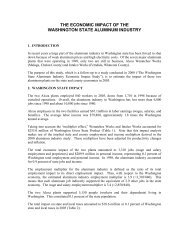WORLD POPULATION TO 2300
WORLD POPULATION TO 2300
WORLD POPULATION TO 2300
Create successful ePaper yourself
Turn your PDF publications into a flip-book with our unique Google optimized e-Paper software.
Population (millions)<br />
2,500<br />
2,000<br />
1,500<br />
1,000<br />
500<br />
0<br />
Northern Africa<br />
Western Africa<br />
Middle Africa<br />
Eastern Africa<br />
Southern Africa<br />
shortly after 2025—it had only 150 million people<br />
in 1950—and will be approaching two billion by<br />
2100.<br />
But it will not get there in these projections.<br />
Even before 2050, population growth is expected<br />
to slow down. Figure 24, in which the 2000-2050<br />
period is set off by vertical lines, shows declining<br />
growth rates for these three regions of Africa,<br />
though growth rates are even lower within Northern<br />
and Southern Africa.<br />
Beyond 2050, population growth substantially<br />
moderates in each region—except in a perverse<br />
sense for Southern Africa, where a growth rate,<br />
still negative by 2050, slowly creeps back to positive<br />
levels. As in 2000-2050, Eastern, Middle, and<br />
Western Africa are again the three fastest growing<br />
regions in the world in 2050-2100, though the<br />
pace is much slower. Growth in these three regions<br />
does turn negative by 2105 and falls to its<br />
lowest level around 2035, about a quarter century<br />
after similar turning points for Northern Africa.<br />
Rapid growth in Eastern, Middle, and Western<br />
Africa has much to do with high fertility (fig-<br />
Figure 23. Total population, African regions: 1950-<strong>2300</strong><br />
1950 2000 2050 2100 2150 2200 2250 <strong>2300</strong><br />
ure 25). In 1995-2000, these three regions have by<br />
far the highest fertility of any region of the world:<br />
between 5.9 and 6.4 children per woman, at a time<br />
when no other region reaches 4.5. By 2045-2050,<br />
these three regions still have the highest fertility,<br />
at around 2.5 children per woman, when almost<br />
all regions are at 2.0 or below, and Northern and<br />
Southern Africa are both at 1.9. By 2145-2150,<br />
however, total fertility in Eastern, Middle, and<br />
Western Africa has fallen marginally below that<br />
in every other region, at 1.91-1.97, versus 2.04-<br />
2.09 everywhere else. Given the way fertility is<br />
projected, these three African regions will be the<br />
last regions with subreplacement fertility, which<br />
will not disappear until shortly after 2150. Population<br />
growth in these three regions of Africa from<br />
2050 to 2100, however, is still related to high fertility—not<br />
entirely contemporaneous high total<br />
fertility but also previous high fertility that has<br />
produced a young population and consequently<br />
many more children.<br />
Figure 24 shows some irregular growth patterns<br />
in the recent past, as well as an exceptionally<br />
steep fall in the growth rate for Southern Africa.<br />
Much of the irregularity, as well as the steep fall,<br />
United Nations Department of Economic and Social Affairs/Population Division 29<br />
World Population to <strong>2300</strong>





